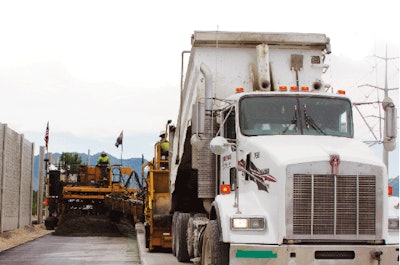How the use of stringless paving technology on the Utah I-15 Corridor Expansion Project saved time and money.
By Tina Grady Barbaccia
When placing concrete, staying within the determined lines is absolutely critical to achieving accurate pavement smoothness and thickness in the proper location. But the use of total robotic stations with 3-D modeling enables paving with added accuracy without physical stringlines.

Conventional concrete-pavement construction uses a physical guidance system with a string or wire – i.e. a stringline – on one or both sides of the paving train of equipment to ensure there is proper pavement thickness and alignment. This method uses both horizontal and vertical control for the equipment to place the necessary pavement thickness in the required location, according to Iowa Department of Transportation and the Iowa Highway Research Board in the National Concrete Pavement Technology Center at Iowa State University’s Stringless Portland Cement Concrete Paving Final Report (Project TR-490).
The placement and verification of the stringline is time intensive and can limit access to the area in front of the slipform paver because a space is needed on each side of the paving machine to set the survey control line near the paver.
Stringless control allows the guidance without the need for a physical stringline. The system, which controls the paver through radio signals, depends on robotic station technology. The paving sequence is completed in a controlled environment. The paver is fed information, which enables operators to make small adjustments during the paving process.
 Provo River Constructors (PRC) reconstructed 24 miles of freeway with two lanes in each direction using stringless paving in the Utah 1-15 Corridor Expansion Project. The project was completed two years ahead of schedule.
Provo River Constructors (PRC) reconstructed 24 miles of freeway with two lanes in each direction using stringless paving in the Utah 1-15 Corridor Expansion Project. The project was completed two years ahead of schedule.Use of stringless paving technology proved to be important with Utah’s 1-15 Corridor Expansion Project, which reconstructed 24 miles of freeway from Lehi, Utah, to Spanish Fork, Utah. The project widened the freeway by two lanes in each direction; replaced the original asphalt with new 40-year concrete pavement; extended the Express Lane from Lehi Main Street to Spanish Fork and rebuilt or replaced 63 bridges and 10 freeway interchanges. The complex project was completed nearly two years ahead of the Utah Department of Transportation’s (UDOT) original schedule. It was finished in 35 months, making it the fastest billion-dollar public highway project ever built in the United States.
Massive job, more efficiency
The upfront challenge was the “sheer magnitude” of the project, says Kelly Steeves, concrete paving manager for Provo River Constructors (PRC), the joint-venture paving contractor for the project comprised of Ames, Floure, Ralph L. Wadsworth and Wadsworth Brothers. “The typical concrete paving job let is 150,000 to 200,000 square yards per construction season,” says Steeves, who is now paving account manager for Leica Geosystems North America, a manufacturer of total robotic stations used in stringless paving. “We completed 2.8 million square yards of concrete paving in two years.”
The added efficiency of using stringless paving technology enabled the team to complete the job ahead of schedule and under budget, he says. “Typically, it takes roughly two days to set up for one paving pass on a project,” he explains. “We had more than 1,000 pave passes. When you do the math, you are automatically out of days to get the job completed in time. The dynamics of this job was pretty much 24/7 for two years.”
But the PRC team managed to complete it ahead of schedule and under budget. The $1.5 billion project had a $1.725 billion price tag (including ROW) in the original request for proposal. The project, which began Jan. 1, 2010, was completed on Dec. 31, 2012. The original completion date was slated for Dec. 31, 2014. The original length of portland cement concrete pavement was 14 miles, but 22 miles were actually completed.
In 2010, 380,993 total square yards were completed. In 2011, 1,380,061 square yards were completed, and in 2012, 1,038,946 square yards were completed. The last slipform paving day was Aug. 29, 2012.
The labor cost of placing and removing the stringlines and the difficulty of working around the paving pins and string lines throughout a project is eliminated with stringless paving, which helped speed up the I-15 Corridor Expansion project. “Placing and removing the stringlines is a continuous job that occupies a small crew throughout the project,” according to the Stringless Portland Cement Concrete Paving Final Report. The related costs include not only the labor cost, but also the cost of the equipment, such as tractors or trucks, that is needed to haul and distribute the stringlines, as well as the actual hardware that is needed for the stringlines.
“The overall challenges of working around the stakes and stringlines can be eliminated leaving fewer obstructions when moving equipment around and preparing the sub-base for paving,” according to the report. “An increase in efficiency and productivity is also possible with more direct routes delivering concrete and materials to the site. The need to build wider shoulders on certain projects can be eliminated without the extra width needed for the stringlines.”
Paving in organized chaos
Aside from the sheer magnitude of the project size, the job team for the I-15 Corridor Expansion faced several other challenges, particularly traffic management. The team had to work under conditions based on maintaining the existing traffic patterns, keeping ramps all ramps open during peak hours and keeping the public traveling through the job while only about 9 feet away and with traffic 2 feet away.
“It was paving in ‘organized chaos,’” Steeves says. To make it work, Steeves says, extensive paving plans that detailed all paving passes as well as daily meetings amongst the paving group to cover new issues that came up each day and coordinate with other work being completed. Some of this work included side slopes being finished; noise wall posts being drilled, set and concreted in place; noise wall panels; sharing the same haul road; barriers being built; curb and gutter work; and drillers for the sign foundation.
Coordinating the paving plans was easier because the planning occurred ahead of time in an office instead of on the jobsite. “You get the design files brought over – D45 files, a file format similar to a PDF – manipulate them to smooth out transitions and then work out the vertical curves,” Steeves says. “When you string point to point, you end up with a straight line.”
However, being able to manipulate a file in AUTOCAD and add more points allows a better radius to be developed, he continues. D45 modeling shows the machine operator a steering reference line – “virtual stringlines in the project coordinate system” – a reference point and a steering offset. Similar to a stringline, using a rectangular grid with stringless paving is suggested, but surveying is not necessary. The project can be modeled with as many or few details as needed for vertical, horizontal curves, transitions and super elevations. The model can represent existing stringline data, slab edges – i.e. “virtual slabs” – or any arbitrary offset (position and/or height).
The future of stringless paving
Steeves says eliminating the wire line on a jobsite creates safer working conditions for crews because they do not have to constantly step over it or manage the gates for the truck entrances, conventionally set up about every 600 to 800 feet. “Wireless technology allows trucks to come in ahead of the paver safety and back up a minimal distance,” Steeves says.
Minimizing backup increases paving efficiency, Steeves says. Using stringless technology increases the efficiency because the contractor can start paving as soon as the subgrade is verified instead of waiting for the paving pins to be set and for their own crews to set the stringlines. Such was the case with the Utah 1-15 Corridor Expansion project.
Progressive contractors are more often than not asking counties and DOTs to create 3-D digital designs of their projects to be entered into the paving machine control systems, Steeves says. “In the future, most design work will be done on these digital programs,” he says. “The way technology is advancing so rapidly, contractors are pushing DOTs to provide digital files.”
What you need to know about implementing stringless paving
1. Create a survey control network. “All of this is based off of your existing roadway,” says Kelly Steeves, concrete paving manager for Provo River Constructors (PRC), the contractor on the Utah I-15 Corridor Expansion project and now paving account manager for Leica Geosystems. “You don’t want to cut too much or fill too much of an existing road.” Steeves suggests setting up controls “where you still have a smooth roadway, minimizing dirt excavation and moving the dirt around.” He also advises having benchmarks set up as you move through the project, with each standard tying into specific segments of a project “so there aren’t any dips or humps.”
With the I-15 CORE Project, the project team wanted to leave as much of the roadway as possible in the natural elevation. Some variations had to be done with the new bridges. “Those new benchmarks — i.e. controls points — had to be elevated going into a vertical curve and going uphill and back down,” Steeves points out. “All of those had to be smoothed out.”
2. Collect filled survey data of the surface. This requires a great deal of upfront work during the design phase. “Once the design of the roadway is established, this information is used to create the 3-D model,” Steeves explains. “With the existing bridge, we needed to go out and take true elevation shots. Maybe the bridge is off a tenth in elevation or we had to field-fit a section not per design. That is the kind of data manipulation we need to do. Per design, we are at one elevation but the reality is that we may be at another elevation.”
He gives the example of the segment of a slab on the bridge where this was a bump, with one bump being worse in one lane than the other. “Those are the tie-ins that often need to be manipulated,” Steeves says. “Sometimes you fly right over, and you don’t realize you went over a bridge because they are so smooth. This is how it should be.”
Stringless paving helps achieve this type smoothness, Steeves notes, because “with this method, you can see it on a computer screen and can see where the roadway will be. You can really fine tune down to the ‘N’ on the computer and have so much more control over the smoothness without a bunch of wirelines. Tying into a wireline on bridges can be difficult,” Steeves says. There are also major financial incentives for creating smoother pavement from DOTs.
3. Design the roadway and create a 3-D model. It’s important to work closely with the design team to create a model of the project plan. “When paving stringless, the information being fed into the paver is being compared to the design,” Steeves says. DOTs put out paper plans so the contractor must convert 2-D plans into a 3-D D45 file. “It is advantageous to work directly with the designer on a 3-D model because it makes it easier to note if something doesn’t line up on the roadway and correct it before out on the jobsite,” he says.
4. Transfer 3-D model and begin paving. Download the D45 files (similar to a PDF) via a USB stick — i.e. thumb drive—and download to the paver using anon-contact X, Y, Z guidance system. “You just download the file needed for the pave pass,” Steeves says, “and you should be good to go.” On the paver, a computer, software, radios, slope sensors and prisms or GPS and masts are needed to use the 3-D model file and perform stringless paving.
Implementation benefits of stringless paving
Stringless paving eliminates the need for stringlines, which provides the following benefits, according to the National Concrete Pavement Technology Center at Iowa State University’s Stringless Portland Cement Concrete Paving (Project TR-490) research findings:
• Avoid project delays caused by time-intensive staking of stringlines.
• Reduce contractors’ move in and move out times.
• Have shorter construction periods that disrupt traffic.
• Reduce labor costs of placing and removing stringlines.
• Increase the amount of traffic access along the road, especially on county roads where the shoulders are limited.
• Reduce the need to set stringlines in hazardous areas.
• Experience greater work access to the slipform paver and surrounding area.
• Eliminate the need for stringline sensors on paving machines.
• Decrease the overall width of paving machines by eliminating need for sensors, making it easier and faster to cross bridges and other tight spots.
For more findings from this report, visit intrans.iastate.edu.
Stringless Paving: How it works
• Prisms mounted on paving machine reflect signals back to total stations, giving them X, Y, Z positions.
• Information is transmitted via radio signal from total stations to computer on the paving machine.
• The paving machine computer processes the exact position in relation to a computer model of the new pavement.
• Onboard computer adjusts evaluation of machine on each of the four corners of the pan to achieve the correct pavement thickness, crossfall (cross-slope control monitored by sensor) and mainfall (forward and back slope control monitored by sensor).














